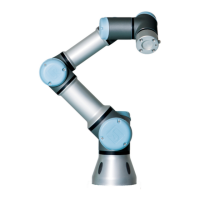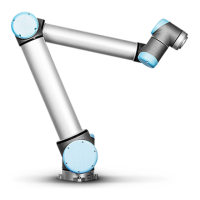14.24 Command: Force
NOTE:
You must do the following:
• Use get_tcp_force() script function in separate thread, to
read actual force and torque.
• Correct wrench vector, if actual force and/or torque is lower
than requested.
Limits selection
For all axes a limit can be set, but these have different meaning corresponding to
the axes being compliant or non-compliant.
• Compliant: The limit is the maximum speed the TCP is allowed to attain
along/about the axis. Units are [mm/s] and [deg/s].
• Non-compliant: The limit is the maximum deviation from the program trajec-
tory which is allowed before the robot protective stops. Units are [mm] and
[deg].
Test force settings
The on/off button, labeled “Test”, toggles the behavior of the Freedrive button on
the back of the Teach Pendant from normal Freedrive mode to testing the force
command.
When the Test button is on and the Freedrive button on the back of the Teach Pen-
dant is pressed, the robot will perform as if the program had reached this force
command, and this way the settings can be verified before actually running the
complete program. Especially, this possibility is useful for verifying that compliant
axes and forces have been selected correctly. Simply hold the robot TCP using one
hand and press the Freedrive button with the other, and notice in which directions
the robot arm can/cannot be moved. Upon leaving this screen, the Test button au-
tomatically switches off, which means the Freedrive button on the back of the Teach
Pendant is again used for regular Freedrive mode. Note: The Freedrive button will
only be effectual when a valid feature has been selected for the Force command.
CB3 II-94 Version 3.4.5
Copyright © 2009–2017 by Universal Robots A/S. All rights reserved.
